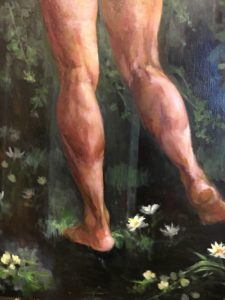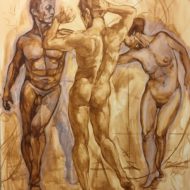There are a lot of art learners who are very interested in Artistic Anatomy. If you love masterpieces by Michelangelo Buonarroti, Leonaldo Da Vinci and would like to make your drawings like those, you will start learning Artistic Anatomy.
However, most of learners cannot keep studying, I’m afraid. This situation what I see is in Japanese learners. They are very interested in it, but have difficulty in keeping on learning. One of the biggest problems for them to keep learning is the complexity and the enormous amount of information about human body.
Muscles and skeletons are like intricate jigsaw puzzles. When you would like to understand a structure of a shoulder, you will open a book of Anatomy then you will find it has a deltoid attached humerus. After that, you will also find pectoralis major connects humerus and sternum and it also controls the movement of a shoulder, or rather, an elbow. At the same time, you’ll also find latissimus dorsi also attaches humerus and it controls internal rotation of an elbow. Then after that, you’ll also find a gap of the connection between an acromion and a clavicle, both are not parts of humerus. At this stage you will be at a loss what “shoulder” is. Or, you will understand if you want to know ” a shoulder”, you need to learn not only a shoulder but a breast and a back, at least.
All in all, you need to learn whole body parts. One separated parts such as ” a shoulder”, ” a breast”, “a back” are not enough. To understand one part, you need to understand whole because human body is like that. If you want to hold something, you need to move your everything.
That’s very hard to organize what you learned and you might quit learning Anatomy.
When you are tired of inputting Anatomy knowledges in your brain, how about outputting? It makes clear what you understand and what you do not understand.
Please try to go out and you’ll find some realistic figure works such as statues, pictures. Or you might not need to go out because you can find a tons of thousands of figure works on the internet. All of those have some exaggeration, dramatization to express artists’ beauty. After considering of those deformations, please try to find the unnatural points in the works and explain yourselves in words the reason why it is unnatural.
For example, please find the picture below;

This is a part of my work. The lower legs you see are unnatural.
Lower legs have gastrocnemius. It is biceps muscle and you can see the two swelled parts clearly around the upper calf if the model’s body fat percentage is low and muscular. Plus, that’s the most important point, when he or she stands on tiptoes, you can see the shapes.
Gastrocnemius connects a femur and a calcaneus. When you are going to stand up on tiptoes, you need to move up your heels, which means the length between a femur and a calcaneus become shorter and the gastrocnemius swell because the volume is no change. So the general standing pose does not show such shadows.
If you can explain what unnatural is, your knowledge of Artistic Anatomy starts showing its elements to make your works and to observe masterpieces by Michelangelo.




